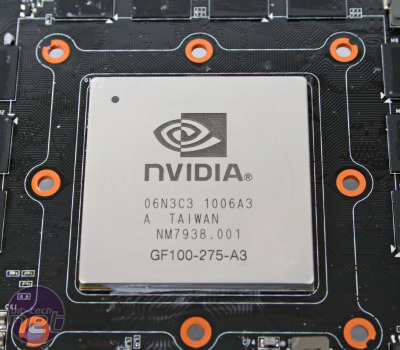
Thermals and Power Consumption
The new GeForce cards are extremely hungry and run extremely hot. Even when idle, the GTX 470 consumed 15W more power than the HD 5870; when loaded, the GTX 470 chewed through 65W more. With the ForceWare 197.17 BETA driver that Nvidia supplied to test the card with, we saw the GPU temperature of the card rise to scorching 94°C before the fan started to blow particularly hard, which lead to the delta T figure of 72°C.Considering that the GPU has a thermal limit of 105°C, we wouldn’t be surprised to see a future driver be a little more conservative with the GPU temperature, and little more aggressive with the fan speed. Even so, this card is far from quiet – after five minutes of working hard, the fan spins up and creates a fair racket. Even in our well-ventilated case, the fan blew hard and was clearly audible, even above the general noise of the air-con and general hubbub of the labs.
Conclusion
We’ve waited a long time for this GPU, but after our game tests, we’re left wondering why. Expensive graphics cards aren’t a problem, as long as they deliver, but the GTX 470 doesn’t offer the performance to comprehensively beat the existing graphics card in its price range, the ATI Radeon HD 5870.Only in Dirt 2 at sub-30in resolutions was the GTX 470 conclusively faster than the HD 5870, but even in this game the HD 5870 gained the fps lead at 2,560 x 1,600. In Chaos Rising and Bad Company 2 poor AA handling by ATI cut the GTX 470 some slack, again a positive result for the GTX 470 considering that it’s a high-end card that should be used with plenty of AA.
However, the GTX 470 can only just play Chaos Rising at 1,920 x 1,200 with 4x AA (with a minimum of 24fps, compared with the 21fps minimum of the HD 5870) and both these cards can comfortable play Bad Company 2 at 1,920 x 1,200 with 4x AA (with 30+fps minimums from both). The GTX 470 is comparably poor in STALKER: Call of Pripyat and Crysis, which are both great indicators of absolute GPU performance.
Add to this mediocre game performance the noise of the cooler, which is greater than that of the HD 5870, and the much higher power consumption and GPU temperature, and it’s difficult to see any reason to opt for a GeForce GTX 470 over a Radeon HD 5870.
Only a significant price drop to bring the GTX 470 more in line with the HD 5850 would create any interest in the short term. We’ll have to wait until next week to see whether the Fermi architecture has any secrets hiding in its radically redesigned layout.
- Performance
- x
- x
- x
- x
- x
- x
- x
- x
- -
- -
- 8/10
- Features
- x
- x
- x
- x
- x
- x
- -
- -
- -
- -
- 6/10
- Value
- x
- x
- x
- x
- x
- -
- -
- -
- -
- -
- 5/10
- Overall
- x
- x
- x
- x
- x
- -
- -
- -
- -
- -
- 5/10

MSI MPG Velox 100R Chassis Review
October 14 2021 | 15:04









Want to comment? Please log in.